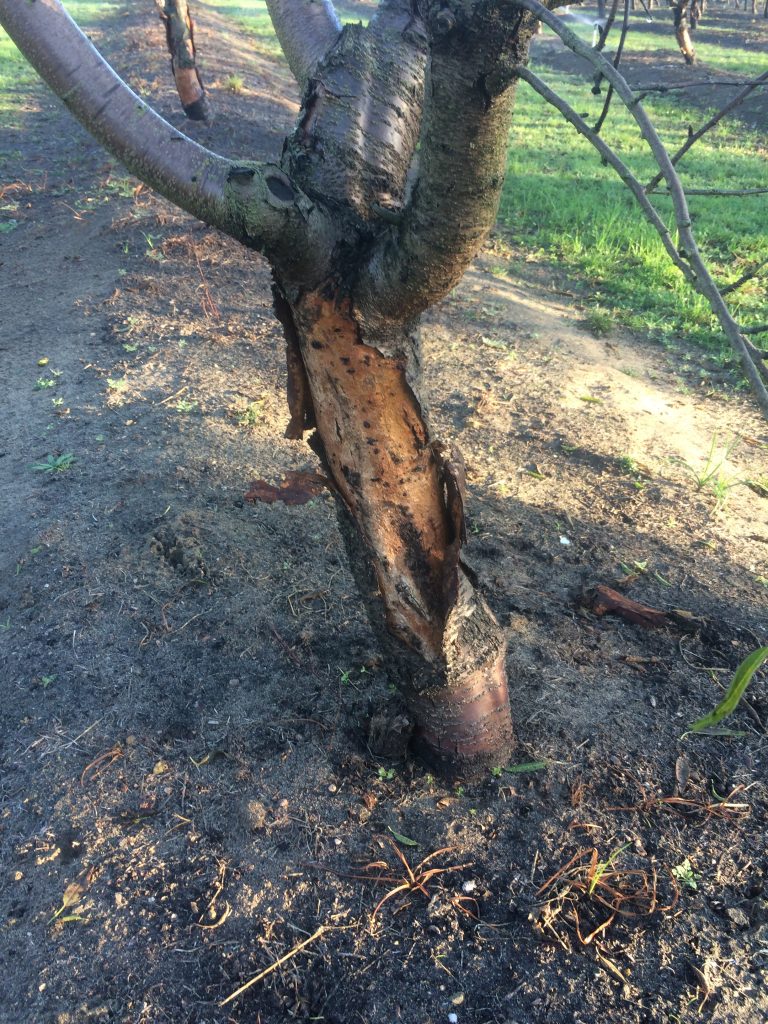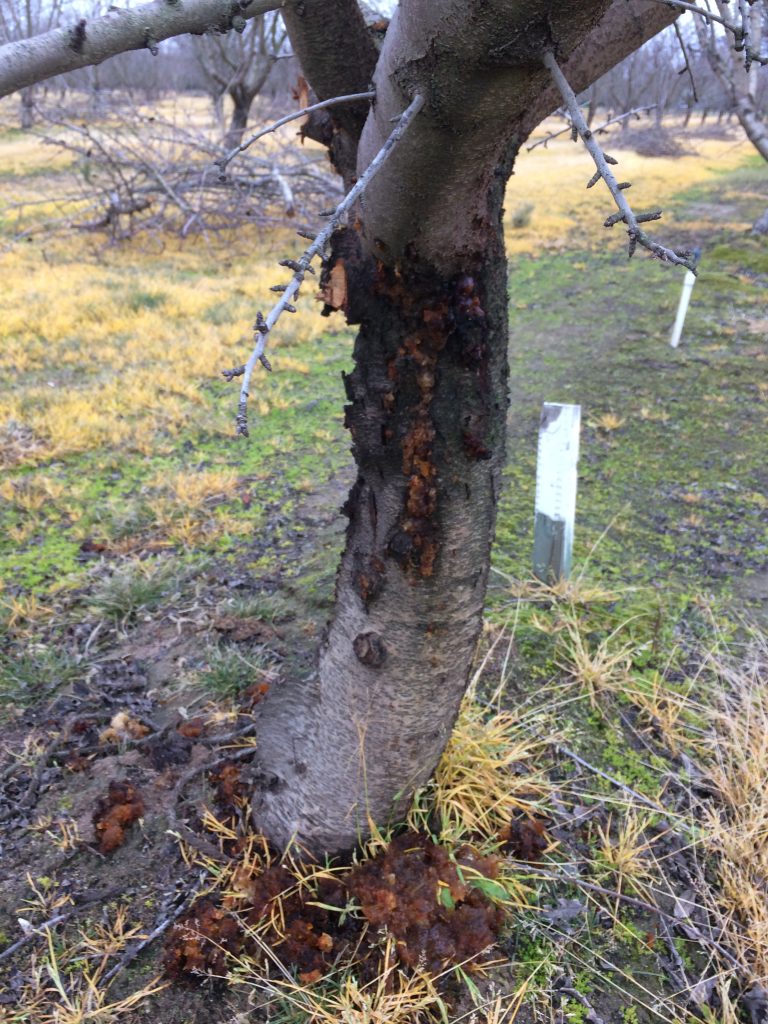
Shaker damage is commonly observed across orchard operations. This damage occurs when the force of the shaker is greater than the strength of the bark, causing it to tear away from the tree. The obvious damage not only impacts tree vigor, but also provides an opportunity for infection by wood canker fungi which can kill the tree. If the shake is properly timed and executed, shaker damage can be greatly reduced (and even eliminated) within an orchard.
A common misconception is that trees that are kept too wet during the harvest period will be damaged by the harvesting process. Interestingly, this has never been supported in research nor found to be consistently true across operations. Research in the mid 90’s by Gurusinghe and Shackel found that withholding irrigation during July through harvest did not reduce bark damage of the trees. To further elaborate, they found no difference in bark strength with respect to shaker damage for almond trees grown under various irrigation treatments. Irrigation treatments included a wet treatment and dry treatment, in which mid-day stem water potential (SWP) was maintained at -9 bar and -20 bar, respectively, through the month of July/August. Despite this range in tree water status, both treatments exhibited the same gradual increase in bark strength through July and August. Based on this, the researchers concluded that water stress did not influence the timing or rate of tree bark strengthening.

Based on the lack of direct effect of moisture status on tree bark strength, it is thought that the damage observed in wet areas of the orchards is most likely due to the delays in ripening. Research has found that decreased water stress (Goldhamer and colleagues, 2006) and high nitrogen status (Saa and colleagues, 2016) both delay ripening. These trees, when shaken at the same time as the rest of the field, are often shaken harder to remove the nuts that aren’t ready to harvest. This harder shake often leads to bark damage. This hypothesis is supported by observations from multiple operations, suggesting that this is the most likely cause of most shaker damage.
To reduce shaker damage, the following practices should be considered:
- Properly time harvest to reduce the force needed for nut removal;
- Improve irrigation distribution uniformity to reduce over-irrigated areas of the orchard;
- Maintain mid-summer leaf nitrogen levels within the range of 2.3-2.5%;
- Develop a shaker operator training and maintenance program to make sure trees are being shaken correctly with proper settings on the equipment;
- And consider starting to harvest later in orchards considered more susceptible to bark damage (e.g. young orchards) to allow for more time for bark hardening.
New shaker operators should be trained and supervised under an experienced operator until they gain familiarity with the equipment. They should be instructed that damaging trees is preventable and if damage occurs on multiple trees (i.e. 1 out of 100 trees), they should stop the harvesting process for further evaluation.
If damage occurs, some practices may help recovery. Damaged bark should be removed from the tree to help the formation of callous tissue. It is currently advised to make a clean cut when removing the bark. After the removal of the bark, research suggests that painting the wound with thiophanate-methyl may help reduce wound infection by Ceratocystis. If mixing with paint, acrylic-based paint should be used over latex or oil.
After the damage is done, it can take multiple years for the tree to recover. Damaged trees will stress easier and may advance through hull-split faster, increasing the risk of insect damage and stick tights. Furthermore, damaged trees will use less water and are prone to over-irrigation. This often leads to the surrounding trees become more susceptible to bark damage due to the delayed ripening from the extra water. Reducing the applied water within the damaged areas is advised.
Works cited or referenced:
Gurusinghe, S.H., Shackel, K.A. 1995. The relation of cambial zone mechanical strength to growth and irrigation of almond [Prunus dulcis (Mill.) Webb.] trees. JASHS 120:170-176.
Saa, S., E. Peach-Fine, P. H. Brown, et al. 2016. Nitrogen increases hull rot and interferes with hull split phenology in almond (Prunus dulcis). Scientia Horticulturae 199: 41-48.
Goldhamer, D., M. Viveros, and M. Salinas. 2006. Regulated deficit irrigation in almonds: effects of variations in applied water and stress timing on yield and yield components. Irrigation Science 24, 2: 101-114.


MAXWELL NORTON
August 21, 2019Excellent summary.
David Doll
August 22, 2019Thanks Maxwell. Wish you the best.
David
croploss
August 27, 2019With whatever respect is due, Ken Shackel was known among his peers for noting and publishing the exception over the rule. There are hundreds of highly experienced PCAs, growers and shaker operators who disagree with Shackel’s claims regarding lack of correlation of water status and susceptibility to shaker damage. Crop maturity stage as affected by variety, fertility status or other issues may certainly be significant, but water status cannot be ignored as a contributing factor.
David Doll
September 29, 2019I won’t disagree with the premise of your statement, but I do disagree in making a conclusion on public sentiment. TO counter, I have seen trees with significant water stress levels (with-held water for two weeks) still have high rates of bark damage (and I know you have too- remember the Gustine case?). As stated in the article, there are multiple confounding factors when reviewing shaker damage. What I wrote is the evidence suggests that irrigation and fertility practices through the season have a greater effect on the frequency of bark damage rather than irrigation practices 5-10 days prior to shaking.
Discussions with multiple custom harvesters with low rates of shaker damage have indicated that as long as the crop is ripe and they don’t leave a tire mark in the field due to wet soil, they wont have shaker damage- unless it was a bad operator. I also have seen minimal shaker damage on over 30,000 acres of almond trees that are consistently shook 24 hours after the last irrigation – a practice they have been doing for over 15 years and have less than 5% damage. These points are anecdotal, but seem to be opposite to the sentiment described.
Does this mean I would irrigate my trees for 24 hours 2 days before harvest. Absolutely not – but keeping my trees without water for 1-2 weeks should not be the alternative advice.
David